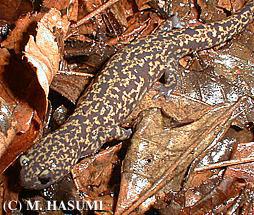
All captures around the torrent were as follows:
H. kimurae:
(1) 5 adult males and 1 seeming subadult under decaying leaves near the right and left banks of the torrent,
(2) 2 adult males and 1 adult female just on the sides of the torrent (these individuals have an intermediate morph at the transition between terrestrial- and aquatic-phase morphs, which provides evidence for wandering behavior (Hasumi and Iwasawa, 1992) that to the aquatic adaptation, salamanders move in and out of the water repeatedly), and
(3) 3 adult males, 3 adult females, and 1 seeming subadult in the torrent; and
Rana ornativentris:
(1) 7 overwintering juveniles in the same torrent.
We released these individuals to sites where they were captured, immediately after taking some photographs and completing all measurements.
The fifth toe of H. kimurae is sometimes missing or barely expressed (Sato, 1943), as well as that of H. lichenatus (Hasumi and Iwasawa, 1987, 1993). In this population, almost all individuals (more than 95%) were tetradactyly (Kakegawa, unpublished data).
Accompanied Collaborating Researchers: Masaichi Kakegawa, Fujio, Kishi, Yuko Saikawa, and an anonymous person.
Hasumi, M., M. Kakegawa, and Y. Saikawa. 2002. A pair of egg sacs deposited under a big stone in Hynobius hidamontanus. Bulletin of the Herpetological Society of Japan 2002(2): 70-72. (In Japanese)
Sato, I. 1943. Monograph of Japanese Tailed Batrachians. Nippon Shuppan-sha, Osaka, Japan. (In Japanese)